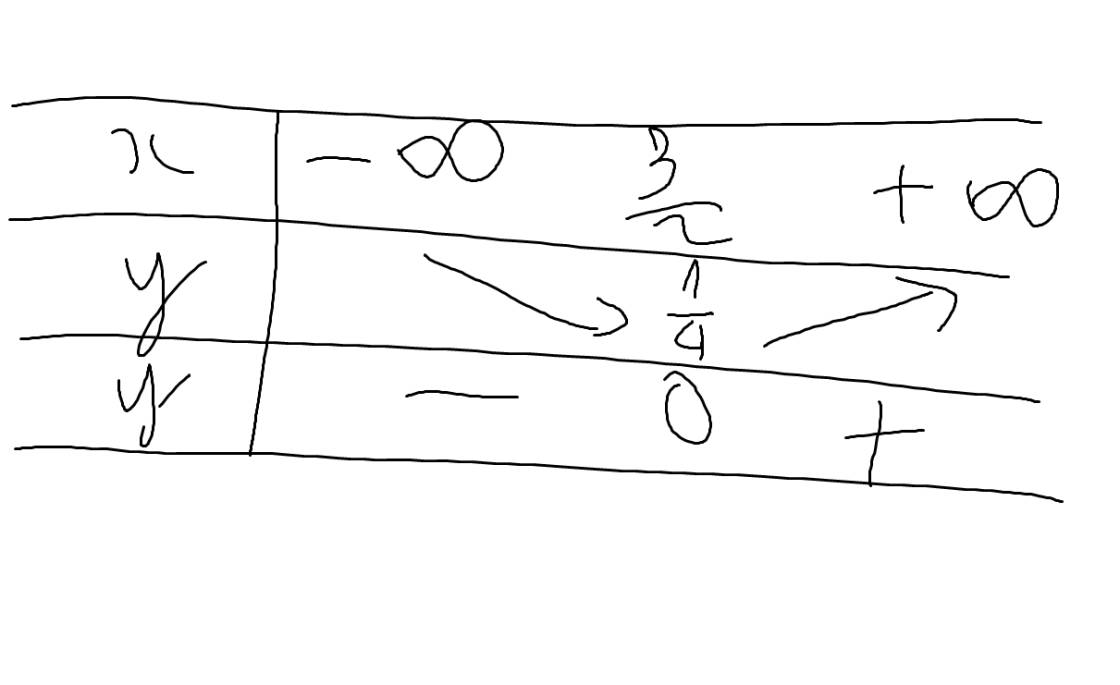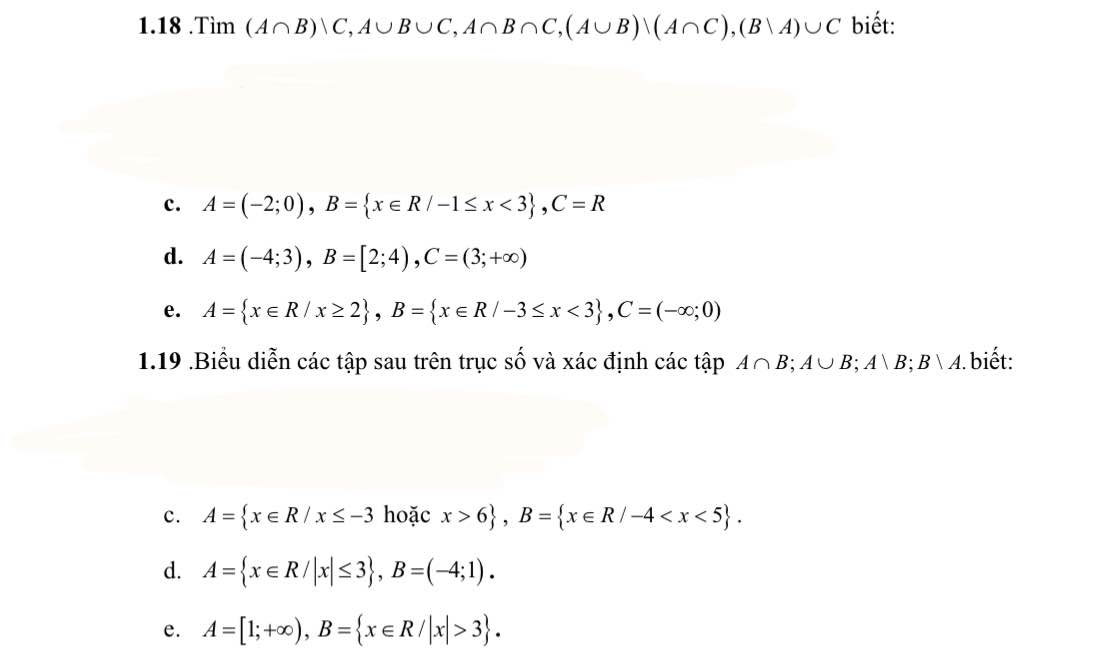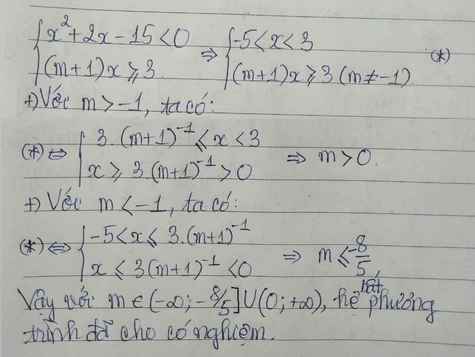
Hãy nhập câu hỏi của bạn vào đây, nếu là tài khoản VIP, bạn sẽ được ưu tiên trả lời.



a) \(d\left(A;\Delta\right)=\dfrac{\left|4.1-3.3+2\right|}{\sqrt{4^2+\left(-3\right)^2}}=\dfrac{3}{5}\)
b) \(\overrightarrow{AB}=\left(-3;-2\right)\) là VTCP của đường thẳng d
PT tham số của d: \(\left\{{}\begin{matrix}x=1-3t\\y=3-2t\end{matrix}\right.\left(t\in R\right)\)
c) Đường tròn (C) có bán kính \(R=AB=\sqrt{\left(1+2\right)^2+\left(3-1\right)^2}=\sqrt{13}\)
PT đường tròn (C): \(\left(x-1\right)^2+\left(y-3\right)^2=13\)

a: Tọa độ đỉnh của (P) là:
\(\left\{{}\begin{matrix}x=\dfrac{-3}{2\cdot\left(-1\right)}=\dfrac{3}{2}\\y=-\dfrac{3^2-4\cdot\left(-1\right)\cdot\left(-2\right)}{4\cdot\left(-1\right)}=-\dfrac{9-4\cdot2}{-4}\end{matrix}\right.\)
=>\(\left\{{}\begin{matrix}x=\dfrac{3}{2}\\y=\dfrac{9-8}{4}=\dfrac{1}{4}\end{matrix}\right.\)
Vì (P): \(y=-x^2+3x-2\) có a=-1<0
nên hàm số đồng biến trên khoảng \(\left(-\infty;\dfrac{3}{2}\right)\) và nghịch biến trên khoảng \(\left(\dfrac{3}{2};+\infty\right)\)
Bảng biến thiên là:

Đồ thị là:

b: Dựa vào đồ thị, ta sẽ có:
Để y>0 thì 1<x<2
c: \(x^2-3x-m=0\)
=>\(x^2-3x=m\)
=>\(-x^2+3x=-m\)
=>\(-x^2+3x-2=2-m\)
Đặt \(y=g\left(x\right)=-x^2+3x-2\)
\(\Leftrightarrow y'=g'\left(x\right)=-2x+3\)
Đặt g'(x)=0
=>-2x+3=0
=>\(x=\dfrac{3}{2}\)

Để phương trình có 1 nghiệm thì \(2-m=\dfrac{1}{4}\)
=>\(m=2-\dfrac{1}{4}=\dfrac{7}{4}\)
Để phương trình có hai nghiệm thì \(2-m\ne\dfrac{1}{4}\)
=>\(m\ne2-\dfrac{1}{4}=\dfrac{7}{4}\)

ĐKXĐ: \(1\le x\le4\)
Đặt \(\sqrt{x-1}+\sqrt{4-x}=t\Rightarrow t^2=3+2\sqrt{\left(x-1\right)\left(4-x\right)}\)
\(\Rightarrow-\sqrt{\left(x-1\right)\left(4-x\right)}=-\dfrac{1}{2}t^2+\dfrac{3}{2}\)
Ta có:
\(\sqrt{x-1}+\sqrt{4-x}\le\sqrt{2\left(x-1+4-x\right)}=\sqrt{6}\)
\(\sqrt{x-1}+\sqrt{4-x}\ge\sqrt{x-1+4-x}=\sqrt{3}\)
\(\Rightarrow t\in\left[\sqrt{3};\sqrt{6}\right]\)
Phương trình trở thành:
\(-\dfrac{1}{2}t^2+t+\dfrac{3}{2}=m\)
Xét hàm \(f\left(t\right)=-\dfrac{1}{2}t^2+t+\dfrac{3}{2}\) với \(t\in\left[\sqrt{3};\sqrt{6}\right]\)
\(a=-\dfrac{1}{2}< 0;-\dfrac{b}{2a}=1< \sqrt{3}\)
\(\Rightarrow f\left(t\right)\) nghịch biến trên \(\left[\sqrt{3};\sqrt{6}\right]\)
\(\Rightarrow f\left(\sqrt{6}\right)\le f\left(t\right)\le f\left(\sqrt{3}\right)\Rightarrow\dfrac{-3+2\sqrt{6}}{2}\le f\left(t\right)\le\sqrt{3}\)
Vậy pt đã cho có nghiệm khi \(\dfrac{-3+2\sqrt{6}}{2}\le m\le\sqrt{3}\)

\(\Leftrightarrow\left\{{}\begin{matrix}x-2y+z=2\\4y-4z=-6\\-y+z=-13\end{matrix}\right.\)
\(\Leftrightarrow\left\{{}\begin{matrix}x-2y+z=2\\y-z=-\dfrac{3}{2}\\-y+z=-13\end{matrix}\right.\)
\(\Leftrightarrow\left\{{}\begin{matrix}x-2y+z=2\\y-z=-\dfrac{3}{2}\\0=-\dfrac{29}{2}\end{matrix}\right.\)
Hệ đã cho vô nghiệm





 làm giúp e câu này với ạ
làm giúp e câu này với ạ



Bài 1.19:
d: A=[-3;3]
B(-4;1)
\(A\cap B\)=[-3;1)
\(A\cup B=\)(-4;3]